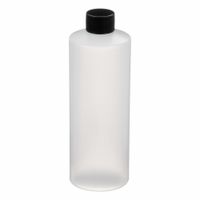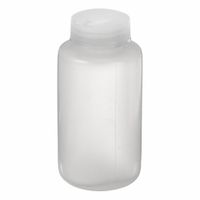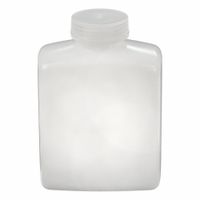Call +(254) 703 030 000 / 751 483 999 / 721 704 777
- Home
- Lab Supplies
- Plastic Glass Containers Closures
- Plastic Lab Containers
- Plastic Lab Bottles
.....Read More
Frequently Asked Questions
What are the advantages of using plastic bottles over glass in laboratories?
Plastic bottles offer several advantages over glass in laboratory settings:
1. **Durability**: Plastic bottles are less prone to breakage compared to glass, reducing the risk of accidents and injuries from shattered glass.
2. **Lightweight**: They are significantly lighter, making them easier to handle, transport, and store, especially in large quantities.
3. **Cost-Effective**: Generally, plastic bottles are cheaper to produce and purchase than glass bottles, making them a cost-effective option for laboratories.
4. **Chemical Resistance**: Many plastics, such as polyethylene and polypropylene, are resistant to a wide range of chemicals, making them suitable for storing various reagents and solutions.
5. **Flexibility**: Plastic bottles can be squeezed, which is useful for dispensing liquids in controlled amounts.
6. **Variety**: They come in various shapes, sizes, and designs, offering more options for specific laboratory needs.
7. **Safety**: In case of a drop or spill, plastic bottles are less likely to cause injury or contamination compared to glass.
8. **Reusability**: Many plastic bottles are designed for multiple uses and can be easily cleaned and sterilized.
9. **Transparency**: Clear plastic bottles allow for easy visual inspection of contents without opening the container.
10. **Compatibility with Equipment**: Plastic bottles are often compatible with various laboratory equipment, such as autoclaves and centrifuges, depending on the type of plastic.
11. **Environmental Impact**: While plastic is often criticized for environmental reasons, certain types of laboratory plastics are recyclable, and their lightweight nature reduces transportation emissions.
These advantages make plastic bottles a practical choice for many laboratory applications.
What types of plastic are commonly used for laboratory bottles?
Common types of plastic used for laboratory bottles include:
1. **Polyethylene (PE):**
- **High-Density Polyethylene (HDPE):** Known for its strength and chemical resistance, HDPE is often used for bottles that store chemicals and reagents.
- **Low-Density Polyethylene (LDPE):** More flexible than HDPE, LDPE is used for squeeze bottles and containers that require some flexibility.
2. **Polypropylene (PP):**
- Offers excellent chemical resistance and can withstand higher temperatures compared to PE. It is often used for autoclaveable bottles and containers that need to be sterilized.
3. **Polyethylene Terephthalate (PET):**
- Known for its clarity and strength, PET is used for bottles that require transparency to view contents. It is also resistant to impact and moisture.
4. **Polystyrene (PS):**
- Offers clarity and rigidity, making it suitable for disposable bottles and containers where visual inspection is necessary. However, it has limited chemical resistance.
5. **Polycarbonate (PC):**
- Known for its high impact resistance and clarity, PC is used for bottles that require durability and transparency. It can withstand repeated sterilization.
6. **Fluorinated Ethylene Propylene (FEP) and Perfluoroalkoxy (PFA):**
- These are used for bottles that require high chemical resistance and can withstand extreme temperatures. They are often used in specialized applications.
7. **Polyvinyl Chloride (PVC):**
- Offers good chemical resistance and is used for bottles that need to be flexible and durable. However, it is less common due to concerns about leaching and environmental impact.
Each type of plastic is chosen based on its specific properties, such as chemical resistance, temperature tolerance, flexibility, and clarity, to suit different laboratory applications.
How do wide-mouth and narrow-mouth bottles differ in laboratory use?
Wide-mouth bottles are designed with a larger opening, which facilitates easy access for adding or removing substances, cleaning, and inserting larger tools or instruments. They are ideal for handling bulkier materials, viscous liquids, or powders. The wide opening allows for faster pouring and reduces the risk of spillage, making them suitable for tasks that require frequent access or transfer of contents. They are often used for mixing, storing, or transferring larger volumes of substances.
Narrow-mouth bottles, on the other hand, have a smaller opening, which provides better control when pouring liquids, reducing the risk of spills and splashes. This design is beneficial for handling volatile or hazardous chemicals, as it minimizes exposure to air and reduces evaporation. The narrow opening also helps in preventing contamination by limiting the entry of foreign particles. These bottles are typically used for storing and dispensing liquids that require precision, such as reagents or solutions in titrations.
In summary, wide-mouth bottles are preferred for ease of access and handling of larger or more viscous materials, while narrow-mouth bottles are chosen for controlled dispensing and minimizing contamination or evaporation. The choice between the two depends on the specific requirements of the laboratory task at hand.
What are the potential risks of chemical leaching from plastic bottles?
Chemical leaching from plastic bottles poses several potential risks to human health and the environment. One primary concern is the leaching of Bisphenol A (BPA), a chemical used in the production of polycarbonate plastics. BPA is an endocrine disruptor, which can mimic estrogen and interfere with hormonal functions, potentially leading to reproductive issues, developmental problems in children, and increased risk of certain cancers.
Phthalates, another group of chemicals used to make plastics more flexible, can also leach into beverages. These are linked to hormonal disruptions, reproductive health issues, and developmental problems in children. Long-term exposure to phthalates may contribute to obesity, diabetes, and cardiovascular diseases.
Antimony, a catalyst used in the production of polyethylene terephthalate (PET) bottles, can leach into water, especially when bottles are exposed to heat or sunlight. High levels of antimony exposure can cause respiratory and skin irritation, and long-term exposure may lead to more severe health effects, including cancer.
Environmental risks include the contamination of soil and water sources as these chemicals leach from discarded plastic bottles. This can harm aquatic life and disrupt ecosystems. Additionally, the breakdown of plastics into microplastics can facilitate the spread of these chemicals, further impacting wildlife and entering the food chain, potentially affecting human health.
Overall, the risks associated with chemical leaching from plastic bottles underscore the importance of proper disposal, recycling, and the development of safer alternatives to conventional plastics.
How do rectangular bottles compare to round bottles in terms of storage efficiency?
Rectangular bottles generally offer better storage efficiency compared to round bottles. This is primarily due to their shape, which allows them to fit more snugly together without wasted space. When placed side by side, rectangular bottles can align perfectly, maximizing the use of available storage area, whether on shelves, in boxes, or during transportation. This efficient use of space can lead to cost savings in shipping and storage, as more units can be packed into a given volume.
In contrast, round bottles create gaps when placed next to each other, leading to inefficient use of space. These gaps can accumulate, resulting in significant wasted space, especially when dealing with large quantities. This inefficiency can increase storage and transportation costs, as fewer units can be accommodated in the same space compared to rectangular bottles.
Additionally, rectangular bottles often provide better stability when stacked, reducing the risk of tipping over. This can be particularly advantageous in retail environments or during transport, where stability is crucial to prevent damage.
However, round bottles may have advantages in other areas, such as ease of handling and pouring, which can be important for consumer satisfaction. They may also be preferred for aesthetic reasons or brand identity.
Overall, while round bottles have their own benefits, rectangular bottles are typically more efficient for storage and transportation due to their ability to minimize wasted space and maximize the number of units stored or shipped.
What are the specific uses of dispensing and dropper bottles in a lab setting?
Dispensing and dropper bottles are essential tools in laboratory settings, each serving specific purposes to enhance precision, safety, and efficiency.
Dispensing bottles are primarily used for storing and dispensing liquids, such as solvents, reagents, and cleaning solutions. They are designed to provide controlled pouring, minimizing spills and waste. These bottles often feature a nozzle or spout that allows for precise delivery of liquids, which is crucial when handling hazardous or expensive chemicals. The materials used for dispensing bottles, such as glass or high-density polyethylene (HDPE), are chosen based on chemical compatibility to prevent reactions with the contents. Additionally, dispensing bottles can be labeled easily, ensuring proper identification and reducing the risk of cross-contamination.
Dropper bottles, on the other hand, are used for applications requiring high precision and small volumes. They are equipped with a dropper cap or pipette, allowing for the accurate delivery of liquids drop by drop. This is particularly useful in titrations, preparing solutions, or adding indicators where exact measurements are critical. Dropper bottles are commonly used in analytical chemistry, biology, and pharmaceuticals for tasks like dispensing essential oils, stains, or biological reagents. The dropper mechanism ensures minimal exposure to air, reducing the risk of contamination and evaporation of volatile substances.
Both dispensing and dropper bottles contribute to maintaining a clean and organized lab environment. They help in reducing exposure to hazardous chemicals, ensuring safety for lab personnel. By providing precise control over liquid handling, these bottles enhance the accuracy and reliability of experimental results, making them indispensable in various scientific and industrial applications.
What considerations should be made when selecting plastic bottles for centrifuge use?
When selecting plastic bottles for centrifuge use, consider the following:
1. **Material Compatibility**: Ensure the plastic material is chemically compatible with the samples and solvents used. Common materials include polypropylene, polycarbonate, and polyethylene, each with different chemical resistances.
2. **Centrifuge Compatibility**: Verify that the bottles are compatible with the specific centrifuge model, including rotor type and size. Check for manufacturer recommendations.
3. **Temperature Resistance**: Consider the temperature range the bottles can withstand, especially if the centrifuge process involves refrigeration or heating.
4. **Centrifugal Force Tolerance**: Ensure the bottles can withstand the maximum relative centrifugal force (RCF) they will be subjected to. This is crucial to prevent breakage or deformation.
5. **Volume and Capacity**: Choose bottles that accommodate the sample volume while allowing for expansion and proper sealing. Consider the fill level to avoid spillage.
6. **Closure System**: Select bottles with secure, leak-proof caps to prevent sample loss and contamination during centrifugation.
7. **Sterility and Cleanliness**: For sensitive applications, consider pre-sterilized bottles or those that can be easily sterilized without compromising integrity.
8. **Transparency**: Depending on the need for visual inspection, choose between clear or opaque bottles.
9. **Reusability**: Determine if the bottles are single-use or can be reused, considering the cost and environmental impact.
10. **Regulatory Compliance**: Ensure the bottles meet any relevant regulatory standards or certifications required for your specific application.
11. **Cost**: Balance the cost with the required performance and durability, considering the frequency of use and budget constraints.
12. **Supplier Reputation**: Choose bottles from reputable manufacturers known for quality and reliability to ensure consistent performance.





